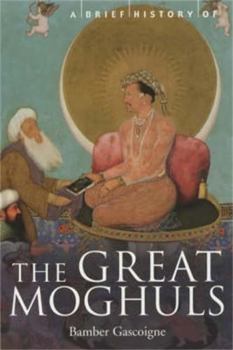A Brief History of the Great Moghuls
Select Format
Select Condition 
Book Overview
'Entertainingly written history . . . ravishingly beautiful photographs.' The Times Bamber Gascoigne's classic book tells of the most fascinating period of Indian history, the sixteenth and... This description may be from another edition of this product.
Format:Paperback
Language:English
ISBN:1841195332
ISBN13:9781841195339
Release Date:January 2002
Publisher:Robinson Publishing
Length:304 Pages
Weight:0.55 lbs.
Customer Reviews
5 ratings
Excellent read
Published by Thriftbooks.com User , 15 years ago
This is an excellent and must read summaries version of the long Great Mogul history.
The Beauty and the Grandeur
Published by Thriftbooks.com User , 17 years ago
The first advice I would give to anyone interested in Bamber Gascoigne's THE GREAT MOGHULS would be, "Buy it in the hardcover edition, even if you have to buy it used." I once owned a brand-new hardcover edition and was foolish enough to sell it. Later I found that it was no longer in print. Reading a paperback library edition, I could really see the difference. There was the same excellent text by Bamber Gascoigne, but the gorgeous photographs by his wife, Christina-- many in full color-- were missing. This is a great defect for any book on the Great Moghuls, because this dynasty was particularly rich in art and architecture. Moghul miniatures combine the vivid hues, attention to detail and exotic flavor of both Hindu Indian and Persian miniatures with the realism of sixteenth-century Western art. As for Moghul architecture-- well of course everyone knows about the Taj Mahal, one of the world's great wonders, and the culmination of a long tradition of excellence. Equally interesting is the personalities of the Moghuls. One is led through the founder of the dynasty, Babur, who transformed his family from mere descendants of the merciless Jhengiz Khan and Tamerlane (the word "Moghul" is a corruption of "Mongol") to a leading agent of civilization in central Asia and later India. One thing Babur kept from his background was a love for the outdoors: thus he preferred to sleep in tents rather than palaces, and this led to the design of gardens which set a beautiful precedent for later Moghul achievements. More surprising for a man of such background was his love of the written word, for he wrote (or to be more precise, dictated) his own biography and thus set another precendent to be followed by his heirs. It is fortunate that he came under the influence of Persian culture, for it above all others had thrown off the ban on the depiction of human and animal forms which limited Islamic art elsewhere. The result was to be stunning. He was succeeded in power by his son, Humayun, to whom he left his greatest conquest, Hindustan. Humayun was a dissolute fellow who is best remembered as the father of the greatest Moghul, Akbar, of whom more later. As it strengthened its hold upon India, the Moghul Dynasty grew more cultivated until it reached its aesthetic height in the reigns of Jahangir and Shah Jahan, whose love for his wife Mumtaz Mahal inspired the Taj. Sadly, the dynasty was to end with a dour bigot, Aurangzeb, but his reign only represented a reaction to the tolerance and flowering of culture that his predecessors had presided over. If the Gascoignes' book has a defect, it is its tendency to slight the greatest Moghul, Akbar. Unfortunately, they provide little information about or pictures of him, although such exist, and even give the wrong birthdate for him, October 15, which is the date officially assigned by courtiers fearful of hostile astrologers, not the real one which was a month later. This neglect of the dynasty's most m
Great Book
Published by Thriftbooks.com User , 18 years ago
Provides a very readable yet comprehensive view of the great Indian rulers. Provides many rich facts but does not burden the reader with too much detail. Must read.
Interesting
Published by Thriftbooks.com User , 19 years ago
Although from India, much of what has been mentioned in this book I did not know. This book is well written and a very good start, since it is presented in an interesting manner. The moguls presented in this book are the main ones i.e., Babur, Humayun, Akbar the great, Jahangir, Shahjahan and Aurangazeb. The moguls were an important part of Indian History and in this book they come across as actual people who once existed along with the rest of the time period. Before you start a warning: Dont look at this book with your present sensibilities, these were people who were a product and a part of their time and not ours. Somehow these brief histories make for a good read. I hope someone writes biographical novels about these colourful rulers.
The Moghul Emperors Come Alive
Published by Thriftbooks.com User , 22 years ago
This is a unique book of its kind, with the history of the Indian subcontinent stretching from Timur's attack of Delhi in 1398 to the banishment and subsequent death of Bahadur Shah in 1862. But the focus is on the glorious history of 181 years of the six great Moghuls like Babur, Humayun, Akbar, Jahangir, Shah Jahan and Aurangazeb. The book is very detailed with their expansionist adventures and exploits, their ruthless family struggles and sporty pass-times, their patronization of arts and architecture, their devotional practices along with their virtues and vices. Over and above all that, their strategies of governance and approach to religion are in focus. Their acts of tolerance and benevolence are given due credit and their cruelties are graphically portrayed. In short the great Moghul era comes alive with the descriptive and substantially accurate account, accompanied by illustrations of 56 pages of color and 94 monochromes. Anyone interested in the history of the Indian subcontinent cannot bypass this book.





